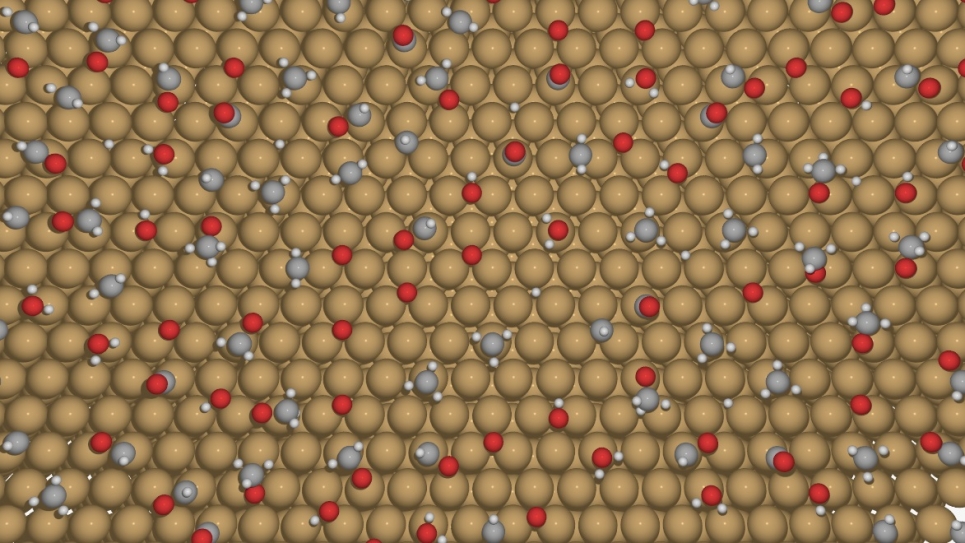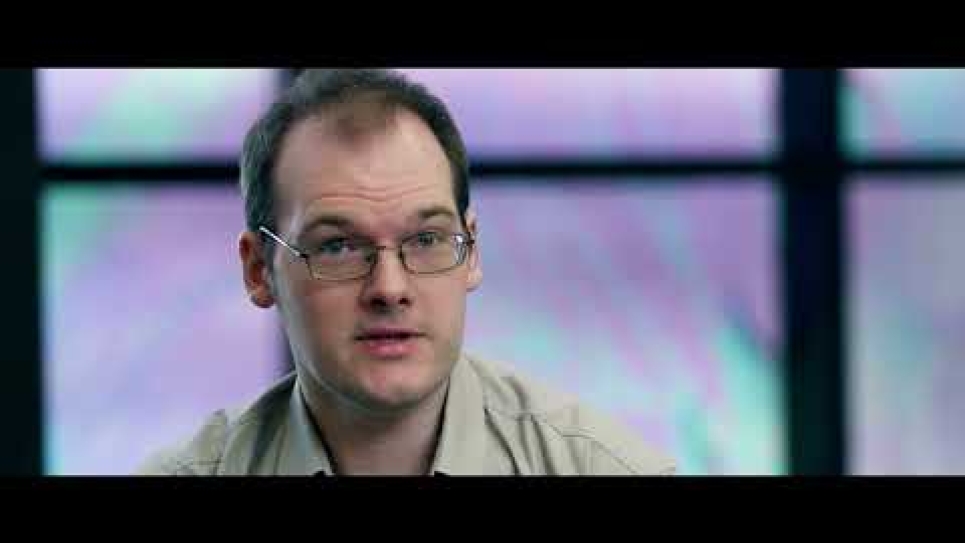
Figure of representative molecules calculated on the surface of Copper(111). (Image by Argonne National Laboratory/David Bross.)
As part of an Aurora Early Science project, researchers are developing exascale software tools to enable the design of new chemicals and chemical processes for clean energy production.
The U.S. Department of Energy’s (DOE) Argonne National Laboratory is building one of the nation’s first exascale systems, Aurora. To prepare codes for the architecture and scale of the new supercomputer, 15 research teams are taking part in the Aurora Early Science Program (ESP) through the Argonne Leadership Computing Facility (ALCF), a DOE Office of Science user facility. With access to pre-production time on the system, these researchers will be among the first in the world to use Aurora for science.
Catalysts are at the heart of industrial chemistry, and industrial chemistry is at the heart of the production of cleaner, more abundant energy. So it should be no surprise that research dedicated to understanding catalysts at the atomic and molecular level is of great importance to the nation.
If you’re picturing people in white coats pouring colorful chemicals into beakers, you might be surprised to learn that much of this research can be done without ever entering a laboratory. Research in this area is what supercomputers across the world are being asked to do with something called the Schrödinger equation. Popularly known for his live-cat, dead-cat paradox, Erwin Schrödinger’s equation has become a cornerstone of modern chemistry and is extremely useful in chemical reaction prediction.
“A molecular understanding of how catalysts work is critical to developing new catalysts for many important applications,” said U.S. Department of Energy’s (DOE) Argonne National Laboratory computational chemist David Bross. “With a complete atomistic description of the underlying chemical mechanisms, scientists can tailor and engineer novel catalysts to advance a number of clean energy technologies.”
As the lead of an Aurora Early Science Program (ESP) project, Bross and his colleagues are gearing up to sit Argonne’s exascale supercomputer down to do some hardcore computational chemistry. Built in collaboration with Intel and Hewlett Packard Enterprise, Aurora is expected to be one of the fastest supercomputers in the world when it is made available for research.

“Having the capabilities of exascale computing will make a lot of things possible that weren’t previously,” Bross said. “The promise of these computers is that you can carry out either very large simulations or a very large number of smaller simulations that were not feasible on previous supercomputers.”
Bross’s Aurora ESP project is linked to the broader DOE Exascale Catalytic Chemistry (ECC) project. Since 2017, the ECC team has been hard at work to get their suite of research software ready for the exascale era. Led by Judit Zádor of DOE’s Sandia National Laboratories, the ECC project includes researchers from Argonne, DOE’s Pacific Northwest National Laboratory, Brown University and Northeastern University.
“One of the main bottlenecks in catalysis development is the wide range of catalysts and operating conditions. It is extremely tedious to identify promising catalytic processes using experiments alone,” Zádor explained. “Our approach in the ECC project is to develop a software infrastructure that allows for the automatic creation of models for these systems, and study their behavior computationally.”
While the ECC project is preparing for all of the nation’s exascale computers, Bross’s ESP project is dedicated to developing and optimizing software for Argonne’s Aurora system. The team’s software tools and techniques aim to advance research into heterogenous catalysis, where the catalyst and the reactant are in different physical phases.
“We’re focused on understanding the interface between solid catalyst surfaces and gas phase molecules,” Bross said. “Many industrially relevant chemical reactions occur in these heterogeneous environments.”
Catalysts are important to many technologies and products we use every day. Almost all industrial processing uses some kind of catalyst to speed up reactions and make them more efficient. Bross pointed to two classic examples of the use of catalysts but noted “new catalysts are being discovered all the time.” One common catalyst is part of the Haber-Bosch process, which is used to create ammonia for fertilizing agricultural crops. Another prominent example is the catalytic converter in vehicles, which turns harmful fuel waste into safer and dispersible chemicals from your tailpipe.
As is the case with the catalytic converter, a main focus of catalysis research is finding chemicals and processes that reduce excess carbon or other toxic chemicals. In making fuels, for example, new catalysts will be needed to lower the carbon footprint of vehicle exhaust.
“Catalysts can be used to deal with different sources of carbon, and to convert them into more valuable chemicals. In effect, to take energy and put it where you want to,” Bross said. “Our main goal is to develop exascale-ready software that can be used to study such systems.”
The team’s software implements new approaches to quickly explore the molecular energy landscapes of gas-solid surface interactions. These tools have the potential to help scientists discover entirely new chemical pathways. And having Aurora’s powerful hardware at the ready will enable much greater accuracy and efficiency in solving the Schrödinger equation.
As part of the ESP project, the team has been working on the ALCF’s Theta and Polaris supercomputers, as well as some early exascale hardware, including the new Sunspot testbed. The researchers work closely with the ALCF’s Raymundo Hernandez Esparza and Álvaro Vázquez-Mayagoitia and the Intel team to ease bottlenecks and finetune performance issues. Bross and his colleagues in the ECC project have already delivered a number of achievements, including publishing scientific papers. They have also shared their open-source software tools on GitHub and made updates to public data repositories.
Another important aspect of the project is the distribution of this software, its processes and publications to researchers worldwide. The team’s work will be open access and promoted to industry and other laboratories, paving the way for further use of exascale computing power in the design and discovery of new catalysts.
“Running our automated workflows coupled with accurate quantum chemical calculations on exascale systems will enable us to look at catalytic systems thoroughly and systematically,” Zádor said. “Using less powerful machines would restrict us to looking at a more limited set of conditions, removing the possibility of seeing the bigger picture in terms of catalytic activity.”
In finding new catalysts, industry can develop more efficient processes that require less energy and create less chemical waste, specifically carbon, that will help lead to a cleaner energy future. “It’s a space with a lot of potential for new discoveries,” Bross said.
The ECC project is funded by Computational Chemical Sciences in the DOE Office of Science’s Basic Energy Sciences.
==========
The Argonne Leadership Computing Facility provides supercomputing capabilities to the scientific and engineering community to advance fundamental discovery and understanding in a broad range of disciplines. Supported by the U.S. Department of Energy’s (DOE’s) Office of Science, Advanced Scientific Computing Research (ASCR) program, the ALCF is one of two DOE Leadership Computing Facilities in the nation dedicated to open science.
Argonne National Laboratory seeks solutions to pressing national problems in science and technology. The nation’s first national laboratory, Argonne conducts leading-edge basic and applied scientific research in virtually every scientific discipline. Argonne researchers work closely with researchers from hundreds of companies, universities, and federal, state and municipal agencies to help them solve their specific problems, advance America’s scientific leadership and prepare the nation for a better future. With employees from more than 60 nations, Argonne is managed by UChicago Argonne, LLC for the U.S. Department of Energy’s Office of Science.
The U.S. Department of Energy’s Office of Science is the single largest supporter of basic research in the physical sciences in the United States and is working to address some of the most pressing challenges of our time. For more information, visit https://energy.gov/science.